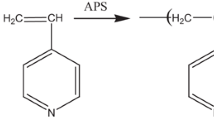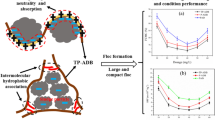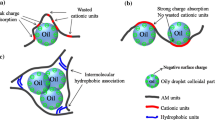Abstract
A new copolymers, high molecular weight poly(acrylamide) [AM2A0.01W20] and [AM1A0.1W20] were synthesized by radical adiabatic copolymerization in aqueous solution. The [AM2A0.01W20] copolymer was hydrolysed in basic medium by using sodium hydroxide solution and leads to a new hydrolysed poly(acrylamide) [AM3A0.01W20-H]. The structure and composition of the copolymers were established by 1H NMR, IRTF and conductivity. The molecular weights are obtained by size exclusion chromatography [SEC] and by viscosity. The variation of the reduced viscosity of aqueous copolymer solutions with copolymer concentration revealed a strong viscosity values showing very high [PAM] molecular weights. In the present work, several copolymer formulations are tested by the process of Coagulation/Flocculation/Decantation with a Jar-test, using a 30 mg L−1 clay suspension. The optimization process shows that the copolymers present different flocculation efficiencies. The copolymers with the best performances were tested on a semi-industrial experimental pilot for the Coagulation/Flocculation/Decantation process. Good Flocculation yield superior than 70 % are observed for the [AM3A0.01W20-H] with high molecular weight.
Similar content being viewed by others
Explore related subjects
Discover the latest articles, news and stories from top researchers in related subjects.Avoid common mistakes on your manuscript.
Introduction
Due to their properties, water-soluble copolymers have continuously attracted widespread interest. In fact, the modified poly(acrylamide) are an extremely important class of synthetic copolymers which are used widely in industrial and laboratory applications [1–6].
Cationic and multiple-functional polyacrylamide (PAM) are important industrial reagents particularly for wastewater treatment thanks to the excellent flocculation function originating from synergistic effects of charge neutralization and bridging adsorption [7–9]. Indeed, the viscosity study of the copolymer poly(acrylamide-co-4-vinylpyridine) was reported in two studies [10, 11]. Baojiao et al. [10] have synthesized poly(acrylamide-co-(4-vinylpyridine)) in organic solvents using potassium persulfate (K2S2O8) as initiator. The obtained copolymers have low intrinsic viscosities [η] and therefore low macromolecular weight (MW).
Gui et al. [11] synthesised and characterised a zwitterionic copolymer of acrylamide and 4-vinylpyridine propylsulfobetaine (AMVPPS) in NaCl solution at 30 °C using potassium persulfate (K2S2O8) and sodium bisulphite (NaHSO3) as initiator. It was found that AMVPPS copolymer was a good flocculent for both anionic kaolin and cationic hematite suspensions and the flocculation performance of copolymer was much better than that of pure poly(acrylamide). The obtained copolymers have also low intrinsic viscosities [η] and therefore low macromolecular weight (MW).
The physicochemical processing of Coagulation/Flocculation are suitable methods to reduce the colloidal materials [12, 13]. The coagulation, as the first step into process of wastewater treatment, consists in neutralizing by decreasing the electric loads and to contribute to linking between the colloidal particles with a size varying between 0.01 and 1 µm. Flocculation is the step which follows the coagulation and promotes contact between the colloidal particles to form agglomerates requiring flocculants such as poly(acrylamide)s [13].
The purpose of this work consists in preparing and characterizing a new poly(acrylamide) copolymers and to test them by the process of Coagulation/Flocculation/Decantation with a Jar-test, and on a semi-industrial experimental pilot.
Materials and Methods
Materials
Bentonite
Suspension solutions were prepared using clay Bentonite issued from the fields of Hammam–Boughrara–Maghnia–Algeria and supplied by a local company known as ENOF. The granulometric analysis of the bentonite has been performed locally in the Civil Engineering Department (Tlemcen University) using a sedimentation technique with a 0.1 % solution of sodium hexametaphosphate. Its chemical composition has been determined by X RAY Fluorescence in the central laboratory of the ENOF [15]. Only the Bentonite fraction with a size <1 µm was only in this work.
Reagents
The acrylamide monomer compound was provided by Merck. Ammonium persulfate (APS) was provided by Aldrich and was used without further purification.
Solvents
The solvent used is bi-distilled water (analytical grade).
Turbidity
Turbidity measurements were conducted on well calibrated HANNA apparatus.
Synthesis of Poly(acrylamide) [PAM]
High weight PAM is prepared by radical adiabatic polymerization of acrylamide [AM] [1] in a reactor (Dewar), in aqueous solution, with ammonium persulfate (APS) as initiating agent. The mixture is stirred and purged with nitrogen for 15 min. One starts the reaction by rapid external heating of the mixture. The High weight PAM polymer is dissolved in water and precipitated in ethanol. The product is then dried under vacuum at room temperature to constant weight and stored in a desiccator. In this paper, the copolymers are noted (AMx/A%/Wy-H) Such that:
- AMx::
-
Mass of acrylamide in the mixture,
- A%::
-
Mass percentage of initiator compared to that of the monomer,
- Wy::
-
Mass of water in the mixture,
- H::
-
Hydrolysed copolymer
Characterization of Poly(acrylamide) [PAM]
The structure was checked by 1H NMR and FTIR spectroscopies. The molecular weight was estimated by the viscosity technique using water as solvent, and by Size exclusion chromatography (SEC).
Conductivity
Conductivity was measured by use of a CDM 210 conduct-meter (Radiometer, Meter Lab.). The studied solutions were contained in a cell glass with double thermostated wall maintained at 25 ± 0.1 °C by use of a circulating thermostat.
Infrared Analysis FTIR
The IR spectra were recorded on an FTIR Perkin-Elmer-2000 spectrophotometer with samples in the form of KBr pellets.
NMR Spectroscopy
1H NMR (400 MHz) spectra were recorded on a Bruker Avance 400 spectrometer, in the solvent D2O.
Viscosity
Viscosity was measured with a standard Ubbelohde capillary viscometer, with a thermostated bath at 25 ± 0.1 °C. The reduced viscosity (η) of the polymer solution was measured at the desired concentration (g mL−1). The viscosity molar mass was then deduced from the intrinsic viscosity [η] using the Mark–Houwink law [2, 14].
Size Exclusion Chromatography (SEC)
Number and weight average molecular weights, Mn and MW, respectively and polymolecularity index.
Ip = Mw/Mn were determined by size exclusion chromatography (SEC) using a Waters Alliance 2690 equipped with Waters Ultrahydrogel 250, 500 and 2000 and refractive-index (RI) detector. The equipment was calibrated with poly(ethyleneoxide) (PEO) standards, and NaNO3 at 0.1 mol L−1 was used as eluent with 0.5 mL min−1 flow.
Results and Discussion
In the present work, we have synthesized new poly(acrylamide) copolymers in order to test them in the process of Coagulation/Flocculation/Decantation. These copolymers were repeatedly precipitated in ethanol and were then dried under vacuum at room temperature to constant weight and stored in a desiccator (Table 1). They were purified by several cycles of dissolution/precipitation in the couple of solvent/non-solvent (water/ethanol).
The copolymers were characterized by proton nuclear magnetic resonance (1H NMR) spectra with a DMX-500 (Bruker, Germany) and in D2O as solvent. The 1H NMR spectrum of AM1A0.1W20 copolymer is shown in Fig. 1 and the related spectral data are reported on the Table 2 [15, 16] and confirms its chemical structure. The signal at 4.7 ppm corresponds to the protons of the solvent.
The molecular weight was determined by water size exclusion chromatography (SEC) using a set of three columns TSK PWXL obtained from TOSO HAAS (length: 30 cm, interior diameter: 7.8 cm) and coupled to an automatic refract-meter and a light scattering apparatus. The molecular weight was also determined by a capillary standard Ubbelohde viscometer, with a thermostated bath at 25 ± 0.1 °C. The molecular weights of newly synthesized copolymers are summarized in Table 3.
Characterization by FTIR Spectroscopy
The copolymers were also characterized by FTIR spectroscopy. The spectral data confirm their chemical structures (Fig. 2). Table 4 summarizes the vibration bands which are attributed to the bonds elongation and deformation. The characteristics of the AM1A0.1W20 polyacrylamide Spectrum are presented in Table 4 [17, 18]. We note that the copolymers AM2A0.01W20 and AM3A0.01W20-H present similar spectra.
Determination of the Basic Hydrolysis Rate of the [AM3A0,01W20-H] Copolymer
The basic hydrolysis rate of the [AM3A0.01W20-H] copolymer was estimated by using the conductivity technique which shows that the percentage of the carboxylate functions [COO−] was about 38 %. In this experiment, the copolymer is dissolved in an excess of sodium hydroxide (10−2 N) to transform all COOH to COO− functions. Then, the OH− functions are firstly neutralized (V1 = 24.16 mL), followed by the COO− functions neutralization which corresponds to the volume (V2−V1). This volume is determined as follows: (V2−V1 = 50.73–24.16 ≈ 50.7–24.2 = 26.5 mL) (Fig. 3).
The general equation is as follows:
where:
m: mass of acrylamide; CHCl: concentration of hydrochlorid acid; n AM : Acrylamide number of moles; M AA : molecular weight of the carboxylate function; n AA : Carboxylate function number of moles, M AM : molecular weight of acrylamide \( {\text{n}}_{\text{T}} = {\text{n}}_{\text{AA}} + {\text{n}}_{\text{AM}} . \)
Jar-Test Flocculation Tests
The samples of the Bentonite suspension are put in four 500 mL containers then flocculent copolymer are added. The process of the flocculation was led during 5 min with a An estimated stirring speed of 100 rpm for a few seconds and 50 rpm. until the end. This step was followed by a decantation for 5 min. Then, samples were taken for turbidity determination.
The flocculent [AM3A0.01W20-H] copolymer shows the following optimized testing results summarized in Table 5. The curve depicted in Fig. 4 shows a maximum of reduced turbidity at Vmax = 5.6 mL. The quantity of the flocculent [AM3A0.01W20-H] was optimized by testing the copolymer using a Jar-test flocculation apparatus. A mother copolymer solution was prepared in aqueous media With a weight concentration of 101 mg L−1. The flocculation tests were conducted on a Bentonite suspension which the weight concentration was 30 mg L−1 and which the initial turbidity was 7.9NTU. The optimization of the dose of the used flocculent was realized at the initial pH value of 6.7. The measured final pH was about 6.8. This shows that the pH variation is small and non significant. In fact, the flocculent based poly(acrylamide) are usually used in the pH range of 6.2–7.0 [3, 6].
The flocculent [AM2A0.01W20] copolymer shows the following optimized testing results summarized in Table 6. The curve (Fig. 5) of the reduced turbidity percentage shows a maximum at about 54.5 % corresponding to a Vmax = 4.3 mL. The quantity of the flocculent [AM2A0.01W20] was optimized by testing the copolymer using a Jar-test flocculation apparatus. A mother copolymer solution was prepared in aqueous media which the weight concentration was 107.66 mg l−l. The flocculation tests were conducted on a bentonite suspension which the weight concentration was 30 mg−l and which the initial turbidity was 7.9NTU. The final turbidities are given in the Table 6. The Bentonite suspension has an initial pH of 6.7 and which rests constant after the flocculation tests.
The flocculent [AM1A0.1W20] copolymer shows the following optimized testing results summarized in Table 7. The curve of the eliminated turbidity percentage shows a maximum at about 31.7 % corresponding to a Vmax = 4.2 mL (Fig. 6).
The quantity of the flocculent [AM1A0.1W20] was optimized by testing the copolymer using a Jar-test flocculation apparatus. A mother copolymer solution was prepared in aqueous media having a weight concentration of 105.66 mg/100 mL. The flocculation tests were conducted in a Bentonite suspension having a weight concentration of 30 mg l−l and and an initial turbidity of 7.9NTU. The final turbidities are given in the Table 7. The Bentonite suspension has an initial pH of 6.7 and which remains constant after the flocculation tests.
Pilot Flocculation Tests
The Flocculation tests are conducted in a semi-industrial installation of coagulation/flocculation as shown in Fig. 7. The Bentonite suspension (30 mg L−l) is filled in the tank of 300 L. The flocculent copolymer is continuously added in the reactor on the Bentonite suspension where the flocculation process takes place. The mixture is then transferred to the decanter where the turbidity is measured as a function of the time.
The flocculent copolymers show the following optimized testing results summarized in Fig. 7. The flocculent [AM3A0.01W20-H] copolymer shows the best reduced turbidity percentages.
As shown in the Fig. 7, the installation consist in a tank of 300 L, a reactor of 20 L equipped whit a helix stirrer with stirring speed of about 50 rpm. A decanter of 40 liters and one reservoir are used to add the flocculent. Two flow-meters and pump heads of type IWAKI (MD-20KZ) are used to add and to calibrate the bentonite suspension and the flocculent into the reactor.
Firstly, two solutions are prepared, the flocculent solution with a known concentration and the bentonite solution with a predetermined concentration of 30 mg L−1. The last suspension is introduced in a tank of 300 L and is homogenized by using an pump. The bentonite suspension and the flocculent alimentations are followed by flow-meters 80 L h−1 and 300 mL h−1, respectively. When the reactor is full, the suspension flow to the decanter previously full by the clear water. Finally, when the decanter is full and the treated water is flowing out, a regular measurement of the turbidity is taken up each ten minutes for 160 min. The initial pH value is 6.7 in the bentonite suspension. The measured final pH was about 6.8. This shows that the pH variation is small and non significant.
For the flocculent [AM3A0.01W20-H] copolymer, the curve of the eliminated turbidity percentage shows a maximum about 70 % after 140 min decantation time. A mother copolymer solution was prepared in aqueous media with a weight concentration of 101 mg L−1. The final concentration in the flocculation reactor is about 1.41 mg L−1. For the flocculants [AM2A0.01W20] and [AM1A0.1W20], the curves of the eliminated turbidity percentages show maximum respectively nearing 54 and 31.7 % after 140 min decantation time. A mother copolymer solution was prepared in aqueous media which the weight concentration was 107.7 mg L−1, for the [AM2A0.01W20] and 105.7 mg L−1, for the [AM1A0.1W20]. The final concentration in the flocculation reactor is about 1.16 mg L−1, for the [AM2A0.01W20] and 1.11 mg L−1 for the [AM1A0.1W20].
The high molecular weight and hydrolysed poly(acrylamide) [AM3A0.01W20-H] is the best flocculating sample tested in this work. Its comparison with the poly(acrylamide) [AM1A0.1W20] which shows the weak flocculating effect shows that the molecular weight plays a great effect in the coagulation/flocculation/decantation process (Fig. 8). The high molecular weight and non hydrolysed poly(acrylamide) [AM2A0.01W20] gives middle coagulation/flocculation/decantation percentages which shows that the electrostatic balance increases the interactions by opening the macromolecular chains. The next step of this work is to quantify the effect of the hydrolysis amount of the high molecular weight poly(acrylamide) on the coagulation/flocculation/decantation process.
Conclusion
High molecular weight poly(acrylamide) new copolymers were synthesized by radical adiabatic copolymerization in aqueous solution. The copolymer structures were established by 1H NMR, IRTF, conductivity, size exclusion chromatography and by viscosity. The copolymer formulations are tested by the process of Coagulation/Flocculation/Decantation with a Jar-test and on a semi-industrial experimental pilot and compared with the literature data [19, 20]. The results show good flocculation efficiencies superior than 70 % in terms of yield.
Two effects have been tested, the molecular weight and the electrostatic balance. In fact, the high molecular weight and hydrolysed poly(acrylamide) [AM3A0.01W20-H] shows the best coagulation/flocculation/decantation yield. Comparatively, the high molecular weight and non hydrolysed poly(acrylamide) [AM2A0.01W20] gives middle coagulation/flocculation/decantation percentages which shows that the electrostatic balance increases the interactions by opening the macromolecular chains. On the other hand, the poly(acrylamide) [AM1A0.1W20] shows the weakest flocculating effect.
In the near future, we will quantify the effect of the hydrolysis rate of the high molecular weight poly(acrylamide) on the coagulation/flocculation/decantation process.
References
Grassl B, Zhu Z, Jian O, Paillet S, Desbrières J (2007) J Eur Polym 43:824–834
Mansri A, Tennouga L, Bouras B (2014) Additive effect on the behavior of water-soluble hydrolyzed polyacrylamide copolymer. J Mater Environ Sci 5:37–42
Aguilar MI, Saez J, Llorens M, Soler A, Ortuno JF, Meseguer V, Fuentes A (2005) Improvement of coagulation–flocculation process using anionic polyacrylamide as coagulant aid. Chemosphere 58:47–56
Tennouga L, Mansri A, Bentrar R, Grassl B (2014) Rheological behavior study of cationic surfactant polyelectrolyte complex (AD37/P4VP-DPC) in aqueous medium. Macromol Symp 339:134–140
Hatice BD, Celia EM, Jean HK, Orhun KM (2009) Biomaterials 30:589
Aizawa T, Magara Y, Musashi M (1990) Acrylamide polymer and its by-products by chlorination in the water treatment process. Aqua 39:334–340
Mansri A, Tennouga L, Desbrières J (2008) Neutralization degree effect on viscosimetric behaviour of hydrolyzed polyacrylamide-poly(4-vinylpyridine) [AD37-P4VP] mixture in aqueous solution. Polym Bull 61:771–777
Zheng BQ, Qian JW, Li XK, Zhu ZH (2007) J Appl Polym Sci 103:1588–1591
Mansri A, Bouras B, Tennouga L, Clisson G, Grassl B (2012) Hydrophobic and electrostatic interactions in the mixture hydrolyzed polyacrylamide–N-dodecylpyridinium chloride (AD37–DPC) in aqueous solution. Res Chem Intermed. http://springerlink.bibliotecabuap.elogim.com/article/10.1007/s11164-012-0961-7
Baojiao G, Yuexian L, Hongfang J (2003) J Polym Int 52:1468–1470
Gui Z, Qian J, An Q, Xu H, Zhao Q (2009) Eur Polym J 45:1403–1405
Lee KE, Norhashimah M, Tjoon T, Beng Teik P (2012) Chem Eng J 203:370–386
Labanda J, Lorens J (2008) Chem Eng Process 47:1061–1068
Mansri A, Tennouga L, Desbrières J (2007) Viscosimetric behaviour of hydrolized polyacrylamide-poly(4-vinylpyridine) [AD37-P4VP] mixture in aqueous solutio. Eur Polym J 43:540–549
Grassl B, Francois J, Billon L (2001) Polym Int 50:1162–1196
Kathmann EE, McCormick CL (1997) J Polym Sci Part A Polym Chem 35:243–253
Rabiee A, Zeynali ME, Baharvand H (2005) Iran Polym J 14:603–608
Arinaitwe E, Pawlik M (2009) Int J Miner Process 91:50–54
Jr Viessman W, Hammer MJ (1993) Water supply and pollution control, 5th edn. Harper Collins College Publishers, New York, pp 860–870
Kawamura S (1991) Integrated design of water treatment facilities. Wiley, New York, pp 658–665
Author information
Authors and Affiliations
Corresponding author
Rights and permissions
About this article
Cite this article
Mansri, A., Bendraoua, A., Benmoussa, A. et al. New Polyacrylamide [PAM] Material Formulations for the Coagulation/Flocculation/Decantation Process. J Polym Environ 23, 580–587 (2015). https://doi.org/10.1007/s10924-015-0734-7
Published:
Issue Date:
DOI: https://doi.org/10.1007/s10924-015-0734-7












